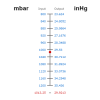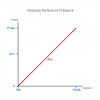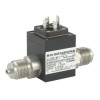Learn the method to convert a differential pressure (DP) sensor for absolute pressure measurement.
- Absolute pressure is measured relative to a perfect vacuum.
- A DP sensor can be used to measure absolute pressure by creating a vacuum on one side.
- The vacuum can be created using a pump or sealed with an isolation valve.
- The pressure to be measured is applied to the other side of the sensor.
- The sensor output represents the pressure difference, which is equal to the absolute pressure since the other side is under vacuum.
Absolute pressure is the measurement of pressure relative to a perfect vacuum, or true zero pressure. This is normally achieved by using a sensor that has a vacuum trapped on the reverse side of the sensing diaphragm.
A differential pressure sensor is designed for pressure to be applied to both sides, and the mechanical design and fittings are designed to be used over a wide range of pressures including the vacuum range. It is therefore possible to apply full vacuum to the negative side of the dp sensor, to create an absolute reference.
The vacuum on the negative side can be created by connecting a vacuum source from a pump to continuously maintain an absolute reference during operation, or a vacuum can be applied and then sealed off using a suitable isolation valve able to provide a leak tight vacuum seal.
When pressure is now applied to the positive side connection of the dp sensor, it will be measured relative to full vacuum, providing an output signal which in exactly the same way as a conventional absolute reference pressure sensor.
Here are the steps to measure absolute pressure with a DP sensor:
- Choose a suitable DP sensor: Select a DP sensor with a measurement range that covers the expected absolute pressure values. Ensure the sensor can handle vacuum on either side.
- Create a vacuum reference:
- Option 1: Continuous pumping: Connect the negative side of the DP sensor to a vacuum pump and maintain the vacuum throughout the measurement.
- Option 2: Sealed vacuum: Apply a vacuum to the negative side using a pump and then seal it off with a leak-tight isolation valve.
- Connect the pressure source: Apply the pressure to be measured to the positive side of the DP sensor.
- Read the sensor output: The DP sensor will output a value representing the pressure difference between the positive and negative sides. Since the negative side is under vacuum (zero pressure), the output directly represents the absolute pressure applied.
Related Help Guides
- Measuring vacuum as a negative gauge pressure using a dp sensor
- How do you measure flow rate with a dp cell
- Measuring liquid level in a tank using a dp sensor
- Measuring density of a liquid using a dp sensor
- Measuring the difference in air pressure between rooms
- Measuring vacuum with negative gauge or absolute ranges
- What is the difference between gauge and absolute pressure measurement
- What is the difference between vacuum and absolute pressure
- Measuring negative pressure using a positive differential pressure range
- What can a DP sensor be used to measure beyond differential pressure?
Related Technical Terms
Related Online Tools
- High and Low Side Pressure to Differential Pressure Calculator
- Gauge + Barometric to Absolute Pressure Calculator
- DP Flow Transmitter Output Calculator





